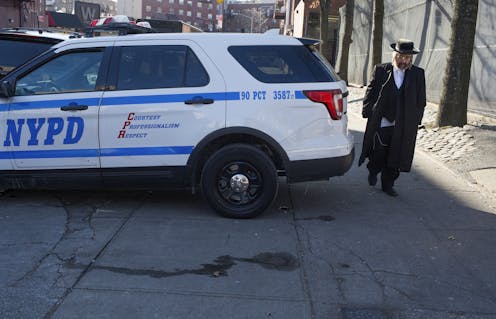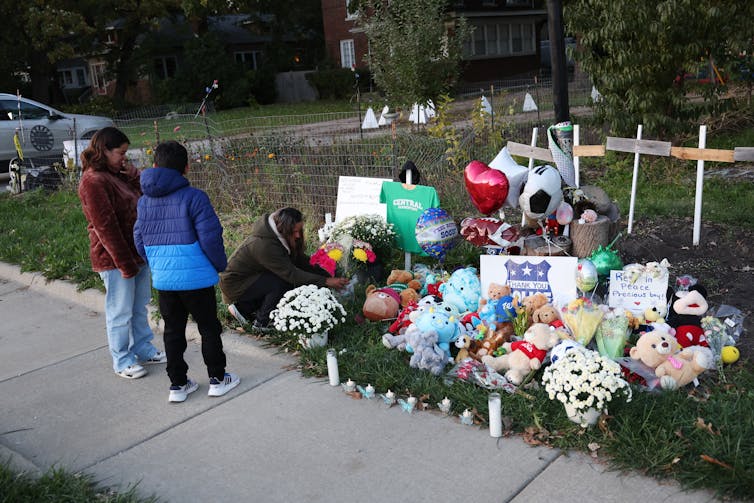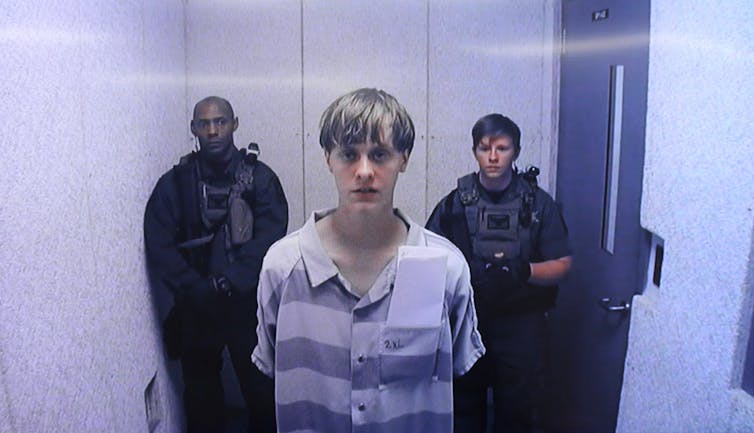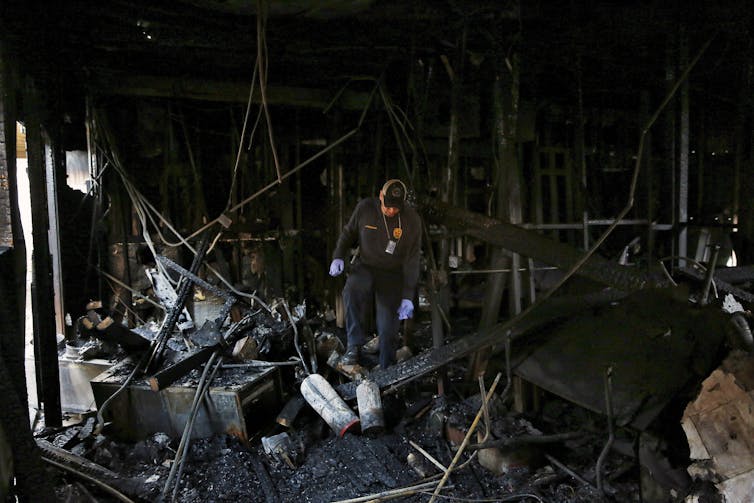
With hate crimes, context is everything, and events outside of the United States – like the war between Israel and Hamas – can have far-reaching and potentially tragic consequences.
Vermont police arrested a man in Burlington on Nov. 27, 2023, for allegedly shooting three 20-year-old Palestinian American men, seriously wounding them. Two of the men wore Palestinian keffiyehs, a traditional scarf that has come to symbolize Palestinian identity.
Jason James Eaton, the New York resident charged with the crime, has pleaded not guilty. Authorities are still investigating whether Eaton should be charged with a hate crime.
People often think an incident is a hate crime right away because of key characteristics of the people involved, but police tend to be reluctant to make such a quick declaration.
Hate crimes and hate murders are rising across the U.S., but long-term polling data suggests that most Americans are horrified by bias-motivated violence. They also support hate crime legislation, an effort to deter such attacks.
Yet officials often resist the quick classification of incidents as a hate crime.
For instance, the shooting of the three Palestinian Americans in Vermont has yet to be classified as a hate crime. Several days later, authorities are still conducting an investigation into what prompted the shooting. Investigations like this are required because hate crimes have precise qualities, which must be met in order to satisfy legal requirements. And even when police and prosecutors believe the elements of a hate crime are present, such crimes can be difficult to prove in court.
A rise in hate since October
The Vermont shooting followed a landlord in Chicago allegedly fatally stabbing a 6-year-old Palestinian American tenant 26 times in October 2023, following a brief discussion with the child’s mother about the war in the Middle East. The assailant, who has pleaded not guilty, was charged with a hate crime.
There has been a sharp spike in attacks on both Jews and Palestinians since Hamas’ attack on Israeli communities on Oct. 7, 2023, and Israel’s subsequent ground invasion of Gaza.
The Anti-Defamation League, an advocacy group that tracks antisemitism, reported at the end of October 2023 that antisemitic incidents increased 388% in the week after Oct 7. These include physical assaults and violent online messages.
In New York City, for example, a man punched a 29-year-old woman in the face before he told her, “You are Jewish.”
The advocacy group Council on American-Islamic Relations has also documented a 216% increase in requests for help and bias incidents compared with 2022 figures.

What is a hate crime?
I have studied hate crime and police for over 20 years.
Hate crimes are crimes motivated by bias on the basis of race, religion, sexual orientation or ethnicity. In some states, gender, age and gender identity are also included. Hate crime laws have been passed by 47 states and the federal government since the 1980s, when activists first began to press state legislatures to recognize the role of bias in violence against minority groups. Today, only Indiana, Mississippi, New Hampshire and South Carolina do not have any hate crime laws.
Both Illinois and Vermont have laws that impose more severe penalties if an alleged offender’s crime is motivated by someone’s race, religion or ethnicity.
In order to be charged as a hate crime, attacks – whether assault, killings or vandalism – must be directed at individuals because of the prohibited biases. Hate crimes, in other words, punish motive; the prosecutor must convince the judge or jury that the victim was targeted because of their race, religion, sexual orientation or other protected characteristic.
If the defendant is found to have acted with bias motivation, hate crimes often add an additional penalty to the underlying charge. Charging people with a hate crime, then, presents additional layers of complexity to what may otherwise be a straightforward case for prosecutors. Bias motivation can be hard to prove, and prosecutors can be reluctant to take cases that they may not win in court.
It can and does happen, though. In June 2020, Shepard Hoehn placed a burning cross and a sign with racial slurs and epithets facing the construction site where his new neighbor, who is Black, was building a house. Hoehn was charged with and later pleaded guilty to federal hate crime charges in Indiana.
A few months later, Maurice Diggins was convicted by a federal jury of a 2018 hate crime for breaking the jaw of a Sudanese man in Maine while shouting racial epithets.

How to charge a hate crime
The first use of the term “hate crime” in federal legislation was the Hate Crime Statistics Act of 1990. This was not a criminal statute but rather a data-gathering requirement that mandated that the U.S. attorney general collect data on crimes that “evidenced prejudice based on race, religion, sexual orientation, or ethnicity.”
Soon, states began passing their own laws recognizing bias crimes. But hate crime legislation has not led to as many charges and convictions as activists may have hoped.
Law enforcement struggles to identify hate crime and prosecute the offenders. Even though 47 states have hate crime laws, 86.1% of law enforcement agencies reported to the FBI that not a single hate crime had occurred in their jurisdiction in 2019, according to FBI data.
In many cases, police have received inadequate training in making hate crime classification.
“What weights do you give to race, dope, territory? These things are 90% gray – there are no black-and-white incidents,” said one 20-year veteran police officer in a 1996 study of hate crime.
But I’ve also found that police departments are rarely organized in a way that allows them to develop the expertise necessary to effectively investigate hate crimes. When police departments have specialized police units and prosecutors who are committed to taking on hate crime, they can develop the routines that allow them to investigate hate crime in a manner that supports victims.
Even law enforcement officers specifically trained in bias crime identification still may not name incidents as hate crime that, to the general public, seem obviously bias-driven. This may be the result of police bias.

Limits of the law
Advocates for hate crime victims maintain that police and prosecutors can do much more to identify and punish hate crimes.
Empirical evidence supports their claims.
The FBI’s latest report on hate crimes, from 2022, found that hate crime incidents rose from 10,840 in 2021 to 11,634 in 2022. But past National Crime Victimization Surveys, in which victims self-report hate crimes, tend to include more incidents than the government documents.
Distrust of police, especially in Black communities, may dissuade minorities from even calling the police when they are victimized by hate crime for fear they could also become victims of police violence.
All this means that perpetrators of hate crimes may not be caught and can re-offend, further victimizing communities that are meant to be protected by hate crime laws.
Hate crime laws reflect American ideals of fairness, justice and equity. But if crimes motivated by bias aren’t reported, well investigated, charged or brought to trial, it matters little what state law says.
This article was updated from a Conversation story originally published on March 19, 2021.
Jeannine Bell does not work for, consult, own shares in or receive funding from any company or organisation that would benefit from this article, and has disclosed no relevant affiliations beyond their academic appointment.
This article was originally published on The Conversation. Read the original article.







